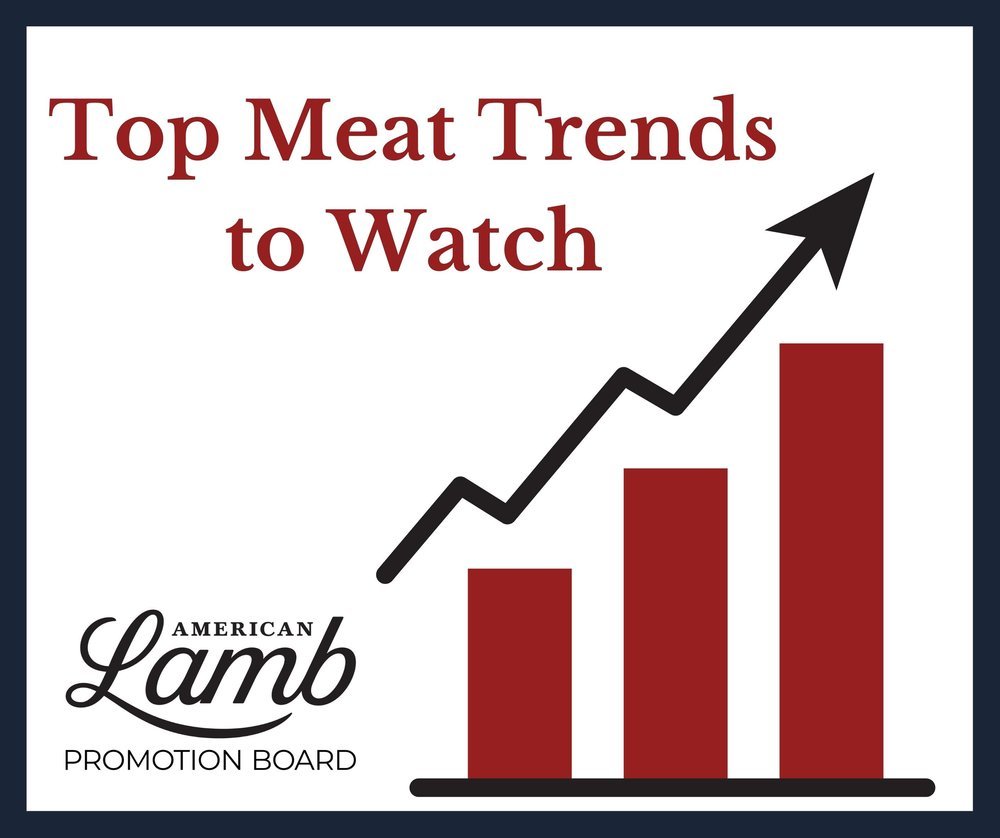Top Meat Trends Expected for 2022
Midan Marketing Issues New Report
There is no question about it, the pandemic has changed consumer behavior.
According to the latest consumer report issued by Chicago-based Midan Marketing, “Consumers have realigned their priorities and are expecting more than ever from the brands they purchase and the retailers they purchase from.” Based on that assertion, Midan’s 2022 Top Trends to Watch identifies 10 trends expected to shape 2022 and beyond. The American Lamb Board (ALB) consults with Midan on selected projects, such as the latest consumer survey of lamb usage and attitudes.
1 – Consumers Crave Convenience
The COVID pandemic has created an increase in what the report terms “convenience chasers” – meat consumers who seek out products that fit their time and money constraints. Midan estimates this accounts for 40% of meat consumers.
Meat processors and marketers are encouraged to provide case-ready packaging that is easy to identify, open and freeze, mess-free, and in product sizes consumers need. Retailers can help solve home-cooking burnout by offering in-store meal kits or other meal solutions that solve consumers’ desire for inspiration and convenience.
In short, all segments of the meat food chain need to meet consumers’ desire for affordable, convenient options.
2– E-commerce is Going Omnichannel
Simple e-commerce offerings are no longer enough. Consumers expect an omnichannel experience – an approach that provides a seamless experience across digital and non-digital platforms.
Social commerce is on the rise and Direct-to-Consumer, or D2C sales are booming. The year 2020 saw TikTok partner with Shopify and the introduction of Facebook Shops. Facebook groups allowed producers to join forces to reach consumers directly. Additional Midan research showed 14% of surveyed consumers have bought food from a local farmer and plan to do it again, while 41% expressed interest in doing so in the future. Insider Intelligence predicted $36 billion in social sales in the US for 2021.
That makes it crucial to sell products on a range of platforms using a consistent brand message. The report reminds retailers that the shopping experience now begins online with consumers looking at digital ads, emails and recipes to plan their food purchases before they choose their purchase platform.
3 – New Retail Technologies
Technology is out to make shopping easier. Amazon now has test stores that allow shoppers with an Amazon account and connected credit card to scan purchases as they shop and skip the check-out lane. And, its Alexa is the new shopping buddy, helping consumers find items in a store or facilitating voice purchasing. Nearly 90 million adults in the U.S. own a smart speaker and around 20% of them use their speakers for shopping activities, such as researching and ordering products or tracking deliveries, according to Midan.
Marketers need to be aware that consumers, especially young consumers, are excited about how technology makes their lives easier and find ways to incorporate it into the shopping experience. Anyone selling meat through retailers needs to find ways to get their brands included in store’s technology-based shopping.
4 – Leverage Social for Human Connection
Social media isn’t going away anytime soon, and for meat marketers and retailers, it continues to offer a powerful way to build relationships with consumers. In fact, in the days of quarantine and solitude, people crave online connection more than ever. Ninety-one percent of people believe in social media’s power to connect people and 79% of consumers want brands to use social to help people connect with each other, according to the report. More than 50% of consumers say they will increase their spending with a brand they connect with and 75% say they’d buy their product over a competitor’s.
Sharing promotions and telling a brand’s story present products and sources as more authentic, strengthening customer loyalty.
5 – The Lost Consumer
Young consumer patterns drive the look to the future but don’t forget the Boomers. They still control 75% of the country’s wealth, yet they are the target of only 5% of advertising. This is the generation that still consumes traditional TV and print advertising. Online advertising can reach them, but it needs to be tailored for both desktop computers and mobile devices.
Regardless of the messaging avenue, a brand has to meet their expectations for brand loyalty to stick. Once it does, they are more likely to maintain it than their younger counterparts.
6 – Branding for B2B
B2B, or Business-to-Business, branding involves every touchpoint of the product and is crucial for getting a product in front of the customer. In 2021 that generally meant an increased web presence. According to one study cited by Midan, e-commerce was the most popular route to market for B2B companies with 41% of leaders saying it is their most effective sales route.
Meat marketers need to visit their own websites through the lens of the retailer and give sales partners a seamless experience, as retailers look for ways to make their product line stand out against competitors.
7– Sustained Support for Sustainability
Sustainability continues to matter to consumers, but they may have a different definition than producers. Producers usually think in terms of environmental impact. Consumers tend to focus on animal welfare. From either angle, consumers see the issue as urgent. The Midan report cites a 32% shift toward action within Twitter sustainability-related conversations in the last year. That includes both consumer personal action and urging companies to do more.
Meat brands need to tell their production story from farm to fork, knowing consumers want to hear the animal welfare side before the environmental story. Targeting and promoting a specific element like food waste or water use can show consumers the brand is being proactive, accountable and transparent.
8 – Wellness Remains Top of Mind
Health and wellness are important to consumers, especially in this pandemic age. Flexitarianism, a plant-based diet with the occasional addition of meat, and Reduceatarianism, a diet that focuses on reducing the consumption of animal products, are diet options consumers are taking increasingly to heart.
Whether the consumer’s motivation is dietary or environmental, meat marketers and retailers need to understand which nutritional attributes are the most important to which segments then package and promote accordingly. That may be highlighting the importance of protein in the diet, providing a blended product for flexitarians, or emphasizing various production practices.
9 – Premium Still in the Game
Consumer interest in premium products has been growing in recent years. The increase in home cooking due to the pandemic raised the bar. According to the report, in 2020 volume sales of USDA Prime beef increased 55% year-over-year, and 2021 added to the gains with consumers of all income levels.
Data analytics and marketing research company IRI predicts despite inflation and rising meat prices, premiumization will continue to be a factor for consumers who want something special on their dinner plates, making it beneficial for the meat industry to continue investing in product quality.
10 – Chaos Continues
Finally, Midan emphasizes there is always chaos after a crisis and that’s where we are now. People’s shifting priorities, supply chain disruptions and inflation continue to affect consumer choices and product marketing. It will take creativity to get products into consumers’ hands in order to maintain product loyalty.
The entire Midan Marketing 2022 Trends to Watch can be found at: https://www.midanmarketing.com/wp-content/uploads/2021/12/Midan-Top-Meat-Trends-Trends-2022.pdf

